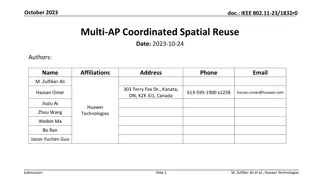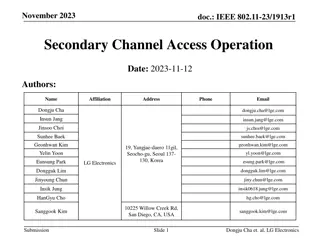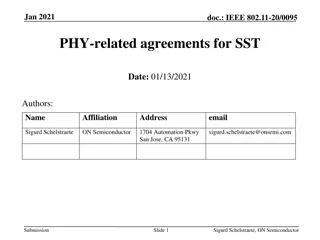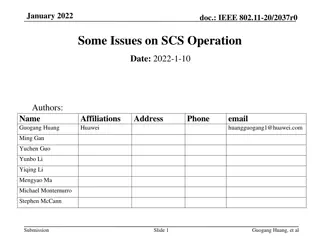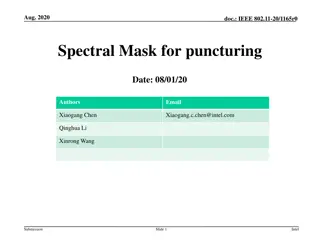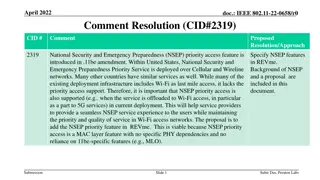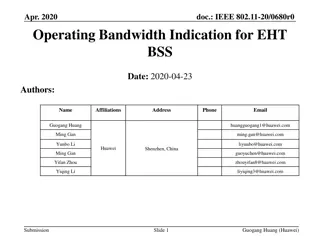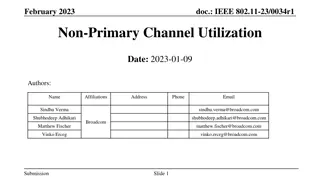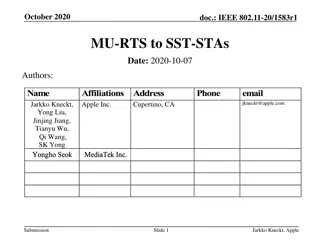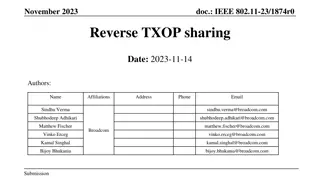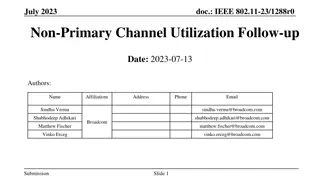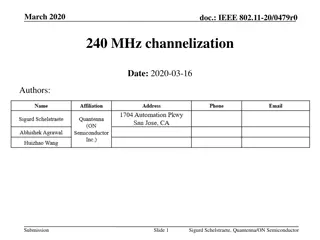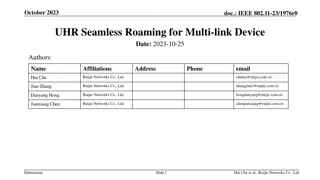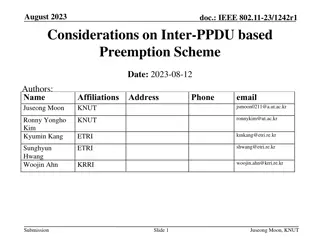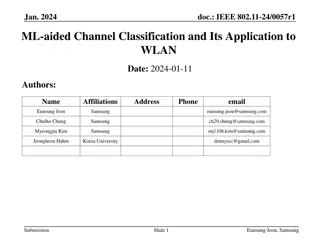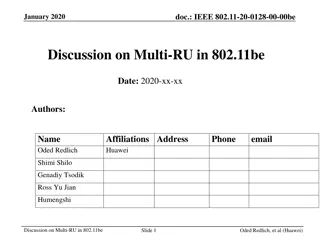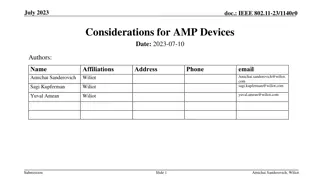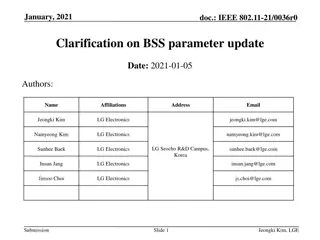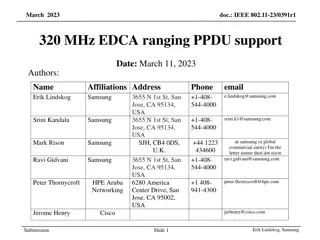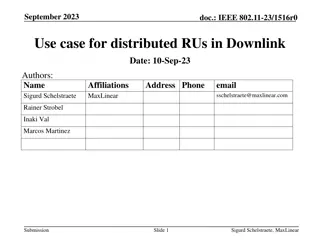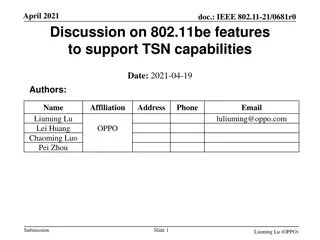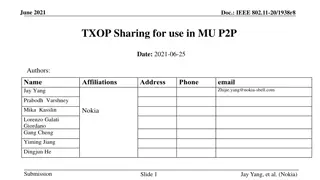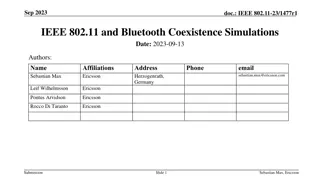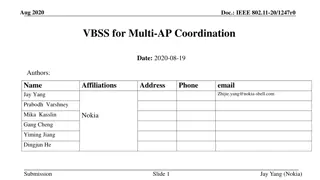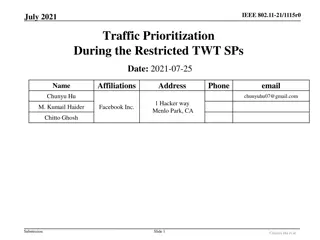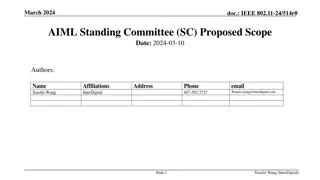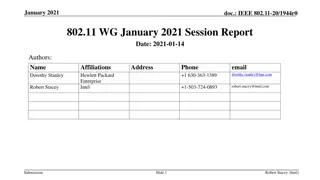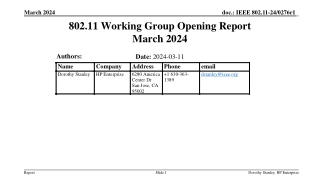Non-Primary Channel Access in IEEE 802.11-23 Standard
This document explores the concept of non-primary channel access in the IEEE 802.11-23 standard to enhance throughput and reduce latency. It discusses scenarios where stations switch to auxiliary primary channels, initiate frame exchanges, and follow back-off procedures to optimize wireless medium utilization. The proposed methodology aims to improve the overall performance of wireless networks by efficiently utilizing available channels.
Download Presentation

Please find below an Image/Link to download the presentation.
The content on the website is provided AS IS for your information and personal use only. It may not be sold, licensed, or shared on other websites without obtaining consent from the author. Download presentation by click this link. If you encounter any issues during the download, it is possible that the publisher has removed the file from their server.
E N D
Presentation Transcript
July 2023 doc.: IEEE 802.11-23/0797r0 Non-Primary Channel Access Date: 2023-07-05 Authors: Name Yongho Seok Affiliations MediaTek Address Phone email yongho.seok@mediatek.com Wilson Taso James Yee Paul Cheng Kaiying Lu Yonggang Fang Li-Hsiang Sun Frank Hsu Gabor Bajko Submission Slide 1 Yongho Seok, MediaTek
July 2023 doc.: IEEE 802.11-23/0797r0 Abstract This contribution discusses the non-primary channel access. o Reduce a latency o Improve a throughput Submission Slide 2 Yongho Seok, MediaTek
July 2023 doc.: IEEE 802.11-23/0797r0 Non-Primary Channel Access When a STA listens on a primary channel a RTS/CTS frame exchange sent by an OBSS STA and sets NAV counter from the PPDU, The STA may switch to an auxiliary primary channel. An auxiliary primary channel is declared by a management frame sent by an AP. After switching to an auxiliary primary channel, A STA invokes a new back-off procedure after sensing the wireless medium on an auxiliary primary channel for TBD time. An auxiliary primary channel sensing can be performed in parallel with the primary channel sensing. Or it can be performed after switching to the auxiliary primary channel. After the NAV counter is expired, the STA shall switch to the primary channel. Submission Slide 3 Yongho Seok, MediaTek
July 2023 doc.: IEEE 802.11-23/0797r0 Non-Primary Channel Access After obtaining a TXOP on an auxiliary primary channel, A STA initiates a frame exchange with the (MU-)RTS/CTS or BSRP/BSR. The TXOP duration on the auxiliary primary channel shall be less than the current NAV counter of the primary channel. After receiving the (MU-)RTS or BSRP frame on an auxiliary primary channel, A STA responds with the CTS or BSR frame if the following is met, The CS of the auxiliary primary channel is idle. The (MU-)RTS or BSRP frame was sent on the same auxiliary primary channel. Submission Slide 4 Yongho Seok, MediaTek
July 2023 doc.: IEEE 802.11-23/0797r0 Non-Primary Channel Access Frame exchange sequence example The STA should check the CS idle on the auxiliary primary channel before obtaining a TXOP. auxiliary primary channel sensing DATA (OBSS) BA RTS CTS DATA BA S80 (OBSS) BA RTS (OBSS) CTS (OBSS) DATA (OBSS) BA DATA P80 (OBSS) But, if a STA can identify the NAV status on the auxiliary primary channel, the STA accounts the channel activity during the identified duration as idle activity. auxiliary primary channel sensing RTS CTS DATA BA S80 BA RTS CTS DATA BA RTS (OBSS) CTS (OBSS ) Slide 5 DATA (OBSS) P80 (OBSS) Submission Yongho Seok, MediaTek
July 2023 doc.: IEEE 802.11-23/0797r0 Simulation-1 Topology 2 BSS: 1 AP and 2 STA in each BSS. Submission Slide 6 Yongho Seok, MediaTek
July 2023 doc.: IEEE 802.11-23/0797r0 Simulation-1 Parameters BSS1: STA 1 and 2 are 160MHz UHR STA with non-primary channel access. BSS2: STA 3 and 4 are 80MHz and 160MHz 11be STA. AP2 transmits either 80MHz or 160MHz SU PPDU to these two STAs. RTS/CTS is enabled. Running UDP DL traffic from each AP to the associated STA. Different 80MHz/160MHz traffic loading from AP2 in BSS2. MCS: 9 Auxiliary primary channel sensing Sequential channel sensing (S-CS): Wait for 0/2.7/4 ms after switch to auxiliary channel. Parallel channel sensing (P-CS): Monitor the aux channel parallelly. The wait time starts from the end of last blindness event on aux channel. Blindness events are tx or rx of own BSS traffic with only lower 80MHz occupied. Submission Slide 7 Yongho Seok, MediaTek
July 2023 doc.: IEEE 802.11-23/0797r0 Simulation-1 With non-primary channel access, there are some opportunities for BSS1 to use upper 80MHz while BSS2 is transmitting on lower 80MHz. Monitoring the auxiliary primary channel (P-CS) could achieve similar performance as S-CS with 0ms wait time. Submission Slide 8 Yongho Seok, MediaTek
July 2023 doc.: IEEE 802.11-23/0797r0 Simulation-1 BSS2 has no performance impact caused by a non-primary channel access mechanism. Submission Slide 9 Yongho Seok, MediaTek
July 2023 doc.: IEEE 802.11-23/0797r0 Simulation-2 Topology 3 BSS: 1 AP and 2 STA in each BSS. Submission Slide 10 Yongho Seok, MediaTek
July 2023 doc.: IEEE 802.11-23/0797r0 Simulation-2 Topology Parameters: BSS1: STA 1 and 2 are 160MHz UHR STA with non-primary channel access. BSS2: STA 3 and 4 are 80MHz and 160MHz 11be STA. AP2 transmits either 80MHz or 160MHz SU PPDU to these two STAs. BSS3: BSS3 is operating on upper 80MHz with a different primary channel. STA 5 and 6 are 80MHz 11be STA. RTS/CTS is enabled. Running full buffer UDP DL traffic from AP1 and AP2 to the associated STA and adjusting UDP DL traffic from AP3 to the associated STAs MCS: 9 Auxiliary primary channel sensing : S-CS and P-CS (refer slide 7) Slide 11 3 BSS: 1AP and 2 STA in each BSS. Submission Yongho Seok, MediaTek
July 2023 doc.: IEEE 802.11-23/0797r0 Simulation-2 When the aux channel is occupied by BSS3 traffic, most of the time non primary channel access from AP1 won t be too aggressive to affect BSS 3. The only exception is when traffic on upper and lower 80MHz are aligned. AP1 and AP2 might transmit 160MHz data which would reduce BSS3 throughput. Either it s collision or less channel access. In general, upper 80MHz is used by BSS3 and lower 80Mhz is used by BSS1 and BSS2. As the traffic load of BSS3 decreases, there is some opportunities for BSS1 to use upper 80MHz while BSS2 is transmitting on lower 80MHz. Submission Slide 12 Yongho Seok, MediaTek
July 2023 doc.: IEEE 802.11-23/0797r0 Simulation-2 BSS 1 throughput Submission Slide 13 Yongho Seok, MediaTek
July 2023 doc.: IEEE 802.11-23/0797r0 Simulation-2 BSS 2 throughput Submission Slide 14 Yongho Seok, MediaTek
July 2023 doc.: IEEE 802.11-23/0797r0 Simulation-2 BSS 3 throughput Submission Slide 15 Yongho Seok, MediaTek
July 2023 doc.: IEEE 802.11-23/0797r0 Conclusion Non-primary channel access can improve the throughput and reduce the latency of the delay sensitive traffic. Depending on the topology, The auxiliary primary channel sensing threshold can have an impact on the OBSS performance. Distance with AP operating on the auxiliary primary channel is less than -62dBm, the CCA threshold of the auxiliary primary channel sensing should be decreased to a value below to - 62dBm (-82dBm in the worst case). We prefer that the AP determines the CCA threshold level and announce to STA. Submission Slide 16 Yongho Seok, MediaTek
July 2023 doc.: IEEE 802.11-23/0797r0 Backup Submission Slide 17 Yongho Seok, MediaTek
July 2023 doc.: IEEE 802.11-23/0797r0 Multiple auxiliary primary channels When an AP supports the parallel auxiliary primary channel sensing, more than one auxiliary primary channel can be declared. The AP can configure the priority of auxiliary primary channels. The highest priority of available auxiliary primary channels is chosen. The STA does not support parallel auxiliary primary channel sensing, it uses only the first auxiliary primary channel. Backoff Inter-BSS PPDU Inter-BSS PPDU Backoff First auxiliary primary channel S160 Second auxiliary primary channel Backoff Inter-BSS PPDU Inter-BSS PPDU Third auxiliary primary channel Backoff Inter-BSS PPDU Inter-BSS PPDU S80 Inter-BSS PPDU Inter-BSS PPDU Inter-BSS PPDU Inter-BSS PPDU P80 Primary channel Case 1 Case 2 Case 3 Case 4 Submission Slide 18 Yongho Seok, MediaTek






